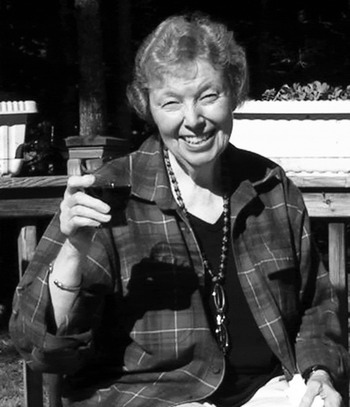Mary E. Petersen (Figure 1) was born in Nyack, New York, to Charles and Helen Wirtenson on 8 February 1938, and passed away in Damariscotta, Maine on 7 July 2014 at the age of 76 after a battle with cancer. Her childhood and early years were spent in New York State. She received a BA in Art and Zoology from Rutgers University, New Brunswick, New Jersey in 1960 and an MA degree in Zoology and Marine Biology from Duke University, Durham, North Carolina in 1964. At Duke, she was accepted into a PhD programme and completed her course work and various examinations before moving to Denmark in 1965. She received a Mag. Scientist Degree from the University of Copenhagen in 1970. While at Duke, she met and married Kay W. Petersen; they subsequently separated, but Mary remained in Denmark and worked at the Zoological Museum of Copenhagen (ZMUC) as a language and technical editor for various publications including Steenstrupia. Mary was fluent at several levels in eight languages. She was affiliated with ZMUC as a Research Associate in polychaetes from 1965 to 2004. Following discussions and an invitation from Dr Les Watling, Mary retired from ZMUC and moved from Denmark to the Darling Marine Center (DMC), University of Maine in Walpole Maine, USA in December 2004 – where she remained until her death in 2014. At the DMC, Mary was given laboratory space and an honorary title, ‘Scholar in Residence’, which allowed her to continue her research on polychaetes.

Fig. 1. Mary Petersen at her home in Maine, August 2007. Photograph courtesy of Vasily Radashevsky.
Mary Petersen's main interest with polychaete systematics and biology was with the following taxa: Cirratulidae, Ctenodrilidae, Chaetopteridae (mainly Chaetopterus), Fauveliopsidae, Heterospio, Pholoe and Sternaspidae. Her approach to each group was to first determine the availability of type specimens, obtain and examine them, and then compare their morphology with new materials. In this effort she examined most of the types of Chaetopterus and numerous poorly known cirratulids. Unfortunately, the types of certain species were not available and this slowed her efforts, especially when materials from type localities were not available. Much of her effort was directed to supposed cosmopolitan species such as Chaetopterus variopedatus and Chaetozone setosa that with careful study have proven to represent numerous species. For such species, she coined the term ‘Characteristic Species Disease’ (Petersen, Reference Petersen1984).
Mary also used reproductive biology to support her systematic work, especially with cirratuliform polychaetes where asexual reproduction and regeneration is prevalent. She and Dr J.D. George demonstrated that the eight species of an entire ctenodrilid genus, Zeppelina, was based on regenerating specimens of the cirratulid genera Dodecaceria and Monticellina (now Kirkegaardia) and the ctenodrilid genus Raphidrilus (George & Petersen, Reference George, Petersen, Petersen and Kirkegaard1991). She later prepared a comprehensive review of cirratulid sexual and asexual reproduction based on her own observations and a compilation of literature, much of which was obscure (Petersen, Reference Petersen, Dorresteijn and Westheide1999a).
In August 1986, Drs Mary Petersen and Jørgen B. Kirkegaard hosted the 2nd International Polychaete Conference (IPC) in Copenhagen. Following the Conference, Mary was Guest Editor of the Proceedings, published in Ophelia Supplement 5 (1991), a book with 723 pages that included 67 papers published and 28 new species described by various authors. Mary was also on the editorial board for the 4th IPC and was co-editor of the Deep-Sea Newsletter with Dr Torben Wolff. Mary attended the 1st to 7th and the 9th IPC conferences and presented papers or posters at each one. She also participated in other conferences and workshops devoted to polychaetes (Figure 2).

Fig. 2. Reception for the Conference ‘Reproductive Strategies and Developmental Patterns in Annelids,’ Osnabrück, Germany, September 1997. Left to right front: Mary Petersen, Pei-Yuan Qian, Adriaan Dorresteijn and James Blake; back: Jonathon Henry and Ulrich Hoeger.
Mary was perhaps best known for her willingness to help other workers by obtaining literature, translating descriptions, reviewing manuscripts, and generally contributing her extensive knowledge of polychaetes. She was often invited to collaborate on various projects. When I was preparing the chapter on Fauveliopsidae for the California Taxonomic Atlas project, it was evident that Mary's knowledge of the fine points of fauveliopsid morphology exceeded my own and I asked her to help with the manuscript and be a co-author, to which she enthusiastically agreed. The resulting chapter was greatly enhanced because of her contribution (Blake & Petersen, Reference Blake, Petersen, Blake, Hilbig and Scott2000). Mary also contributed an excellent chapter of her own on Sternaspidae (Petersen, Reference Petersen, Blake, Hilbig and Scott2000a). Mary's list of collaborators on projects and manuscripts was extensive and among others included Drs M. Bhaud, T. Britayev, M.E. Çinar, J. Fournier, J.D. George, A. Muir, F. Pleijel, V. Radashevsky, C.S.G Santos, J. Vovelle and T. Wolff. A posthumous collaboration with the late Phyllis Knight-Jones has recently been published (Knight-Jones et al., Reference Knight-Jones, Darbyshire, Petersen and Tovar-Hernández2017).
Mary was affectionately referred to as ‘Cricket’ by some of her friends and colleagues. She will long be remembered as a communicator initially by snail mail and Fax; later by e-mails sent at all hours of the day or night. I have one file drawer filled with our correspondence that began in the 1980s and continued for about 25 years. To date, she has 15 species named after her: Entoprocta (1), Polychaeta (12), Oligochaeta (1) and Crustacea (1).
Mary was predeceased by her brother Charles G. Wirtenson, and his wife Janet. She is survived by her cousin Richard Wirtenson and his wife Helen, her niece Julia Cook and husband John and their two daughters. Mary is remembered fondly by her many friends and colleagues throughout the community of polychaete biologists.




